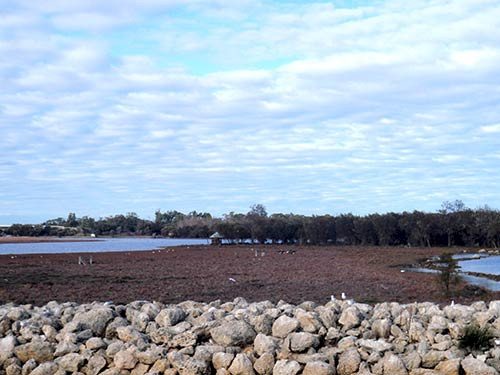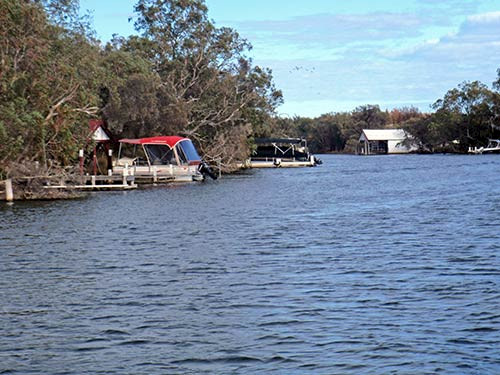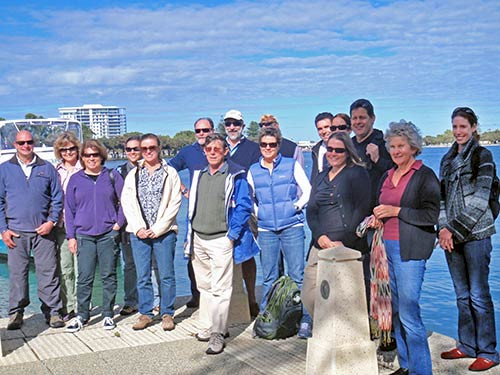A microcosm of the world's water quality problems: Peel-Harvey field trip
Bill Dennison ·As part of the National Estuaries Network meeting, we had a field trip to the Peel-Harvey Estuary on 26 May 2011. This site is a globally significant ecological region for the following reasons: 1) Some of the most massive Harmful Algal Blooms (HABs) ever recorded, occurred in the estuary, 2) A major intervention occurred in which a barrier island breach was constructed (the Dawesville cut), and 3) The occurrence of most of the globally significant HAB species.
We began the trip from Mandjar Bay, in the town of Mandurah, near the natural opening of the Peel-Harvey estuary with the Indian Ocean. Bob Pond and Dan Byrd who were Western Australia Department of Water staff based in Mandurah were our guides. They showed us maps of the region and talked about their water quality results and community engagement.

We traveled to the Mandurah Ocean Marina where the winter navigational dredging was taking place and we could see the Indian Ocean. We saw 'Sammy' the seal, several bottlenose dolphins, pied-eyed cormorants and pelicans. We then traveled toward Peel Inlet via a canal estate where we saw large, unoccupied houses. We learned that there is a significant 'fly in, fly out' population in the region of mining employees who work in northern Western Australia. At the junction of the inlet (Mandurah Estuary) with Peel Inlet were extensive salt marsh flats, which used to be ubiquitous in the region before development. The flats are a major habitat for migratory waterfowl and are dominated by red samphire succulent plants.


We then went directly across the main part of Peel Inlet, a shallow (1-3 m deep) bowl that had the massive accumulations of algae, particularly Nodularia, until 1994, when the Dawesville Cut provided another connection with the Indian Ocean. We could see the development associated with the Dawesville Cut, the junction of Peel Inlet and Harvey Inlet, and smoke emanating from one of the several industrial sites in the watershed (Alcoa). We traveled to the mouths of the two major rivers that enter Peel Inlet at the same location; Serpentine River and Murray River. We learned that the major nutrient inputs were pig manure in the Serpentine River watershed and cow manure in the Harvey River watershed.
We travelled up the Murray River, a river that extends up to the wheat belt of Southwest Australia. The Murray River was lined with small holiday cabins with people fishing, walking and enjoying the waterway. We learned that the Serpentine and Murray Rivers are fairly 'sick' estuaries, yet quite beautiful. The symptoms of degraded health include seasonal anoxia events with associated fish kills, black oozy mud, and the presence of a suite of particularly nasty harmful algal blooms. The list of HABs in these estuaries are literally a 'Who's Who' of globally significant genera; Karenia, Alexandrium, Nodularia, Lyngbya, Microcystis, Dinophysis, and Karlodinium. They can be so dense that they produce a thick 'cappuccino' scum. We learned of the degrading fisheries, which historically included prawns, blue manna crabs, and tailor (the same species of East Coast US bluefish).

We also heard about some of the management efforts in the region. The flat landscape of the watershed has 'gutless gray soils' which have very little organic matter and very little phosphorus retention capacity. The low-lying soils are flood prone, so housing developments that are rapidly occurring in the region require one to two meters of fill to raise the houses above the flood level. A management practice that is being employed is to make soil amendments to this fill used in building that will allow the soils to retain phosphorus more effectively to reduce fertilization requirements. The two materials used for soil amendments are industrial byproducts from mineral sand extraction and bauxite from aluminum processing. The fertilizer sales in the region have limited phosphorus concentrations so combined with soil amendments means that less phosphorus enters the estuary. Another interesting management effort is managed aquifer recharge, a response to the Mediterranean climate of winter rains and hot, dry summers. During winter rains, water is pumped down into the aquifer for storage for use in the dry summer periods.
The Peel-Harvey case study is an example of a short term engineering fix that doesn't resolve the underlying fundamental cause (diffuse nutrient inputs) with the result that the estuarine eutrophication expression is simply converted into a more marine expression of eutrophication. The ongoing development pressures with increasing impervious runoff, hardened shorelines and unchecked agricultural runoff will mean that the microcosm of the world's water quality problems are likely to continue. It will take more than the multi-million dollar engineering to solve the environmental problems in the Peel-Harvey. I am glad that I could see the Peel-Harvey in person and wish the best for the committed scientists and resource managers in their conservation efforts.

About the author
Bill Dennison

Dr. Bill Dennison is a Professor of Marine Science and Vice President for Science Application at the University of Maryland Center for Environmental Science.

